Strategic Analysis of L'Oreal: PESTEL, SWOT, VRIO, and Growth Plans
VerifiedAdded on 2020/10/22
|17
|5201
|67
Report
AI Summary
This report provides a comprehensive business strategy analysis of L'Oreal, a leading cosmetic company. The analysis begins with an introduction to business strategy and an overview of L'Oreal's operations. Task 1 delves into the external environment using PESTEL analysis, examining political, economic, social, technological, environmental, and legal factors. It also includes an internal analysis using SWOT, identifying strengths, weaknesses, opportunities, and threats. Porter's five forces model assesses competitive rivalry. Task 2 explores L'Oreal's strategic direction, evaluating growth platforms and recommending a strategic management plan. The report concludes with a summary of findings and references.
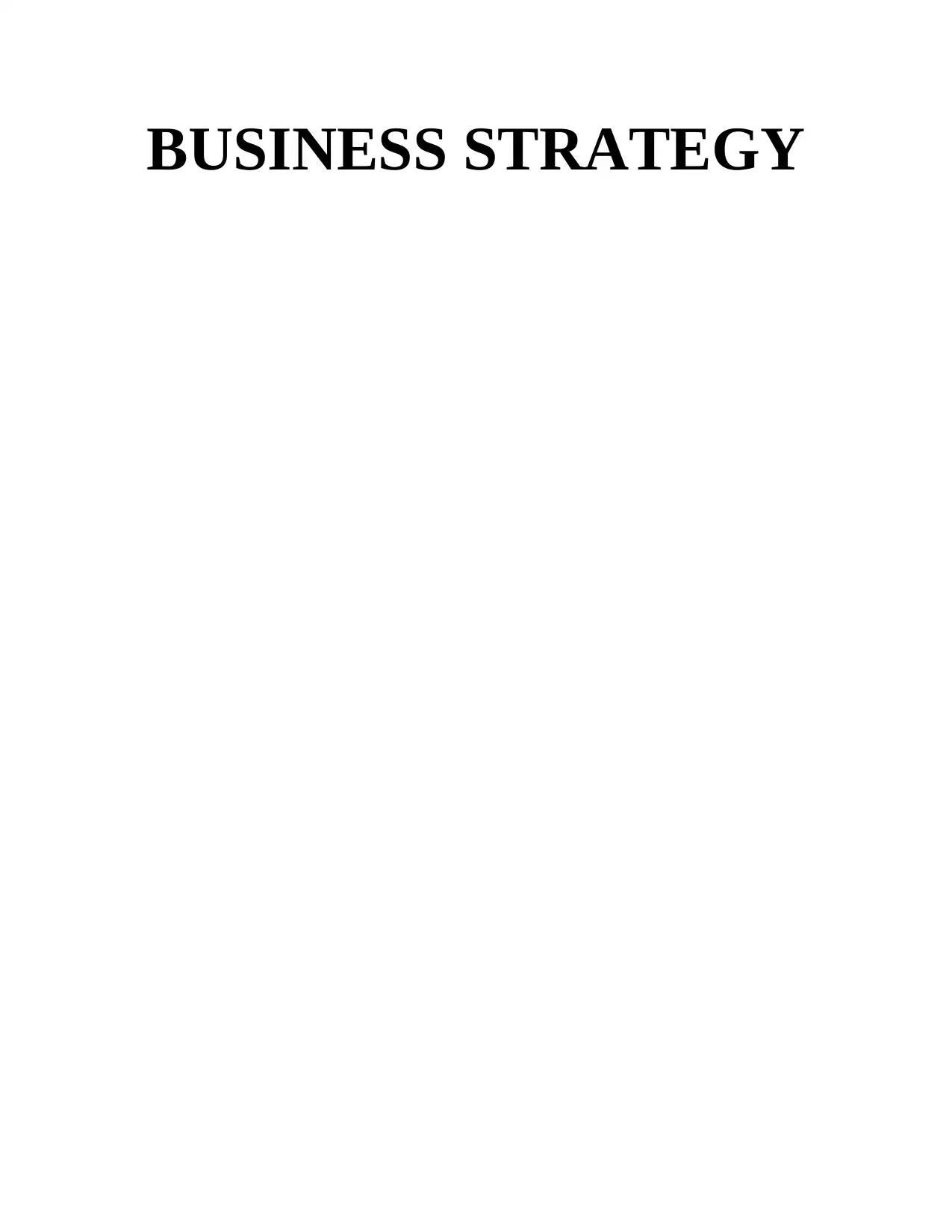
BUSINESS STRATEGY
Paraphrase This Document
Need a fresh take? Get an instant paraphrase of this document with our AI Paraphraser
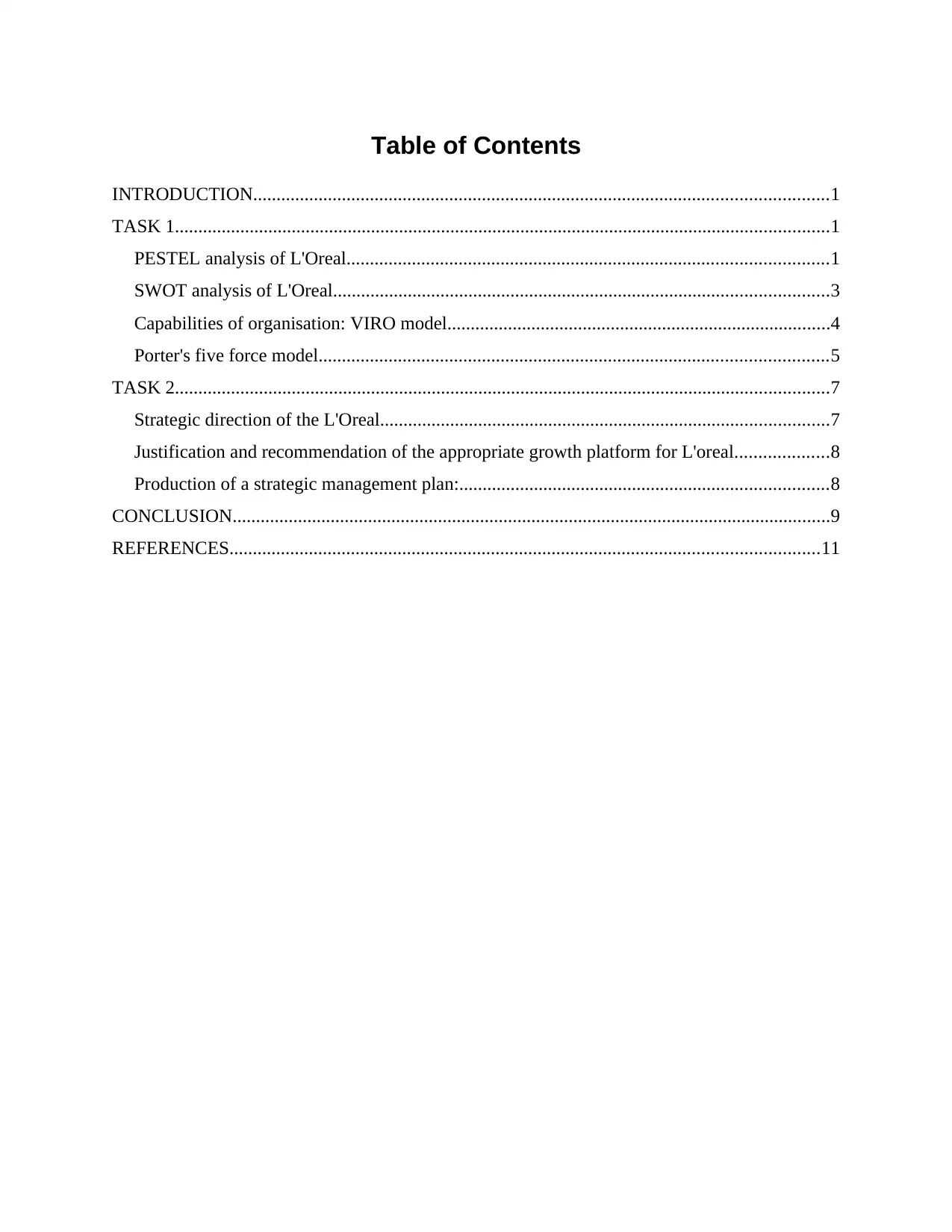
Table of Contents
INTRODUCTION...........................................................................................................................1
TASK 1............................................................................................................................................1
PESTEL analysis of L'Oreal.......................................................................................................1
SWOT analysis of L'Oreal..........................................................................................................3
Capabilities of organisation: VIRO model..................................................................................4
Porter's five force model.............................................................................................................5
TASK 2............................................................................................................................................7
Strategic direction of the L'Oreal................................................................................................7
Justification and recommendation of the appropriate growth platform for L'oreal....................8
Production of a strategic management plan:...............................................................................8
CONCLUSION................................................................................................................................9
REFERENCES..............................................................................................................................11
INTRODUCTION...........................................................................................................................1
TASK 1............................................................................................................................................1
PESTEL analysis of L'Oreal.......................................................................................................1
SWOT analysis of L'Oreal..........................................................................................................3
Capabilities of organisation: VIRO model..................................................................................4
Porter's five force model.............................................................................................................5
TASK 2............................................................................................................................................7
Strategic direction of the L'Oreal................................................................................................7
Justification and recommendation of the appropriate growth platform for L'oreal....................8
Production of a strategic management plan:...............................................................................8
CONCLUSION................................................................................................................................9
REFERENCES..............................................................................................................................11
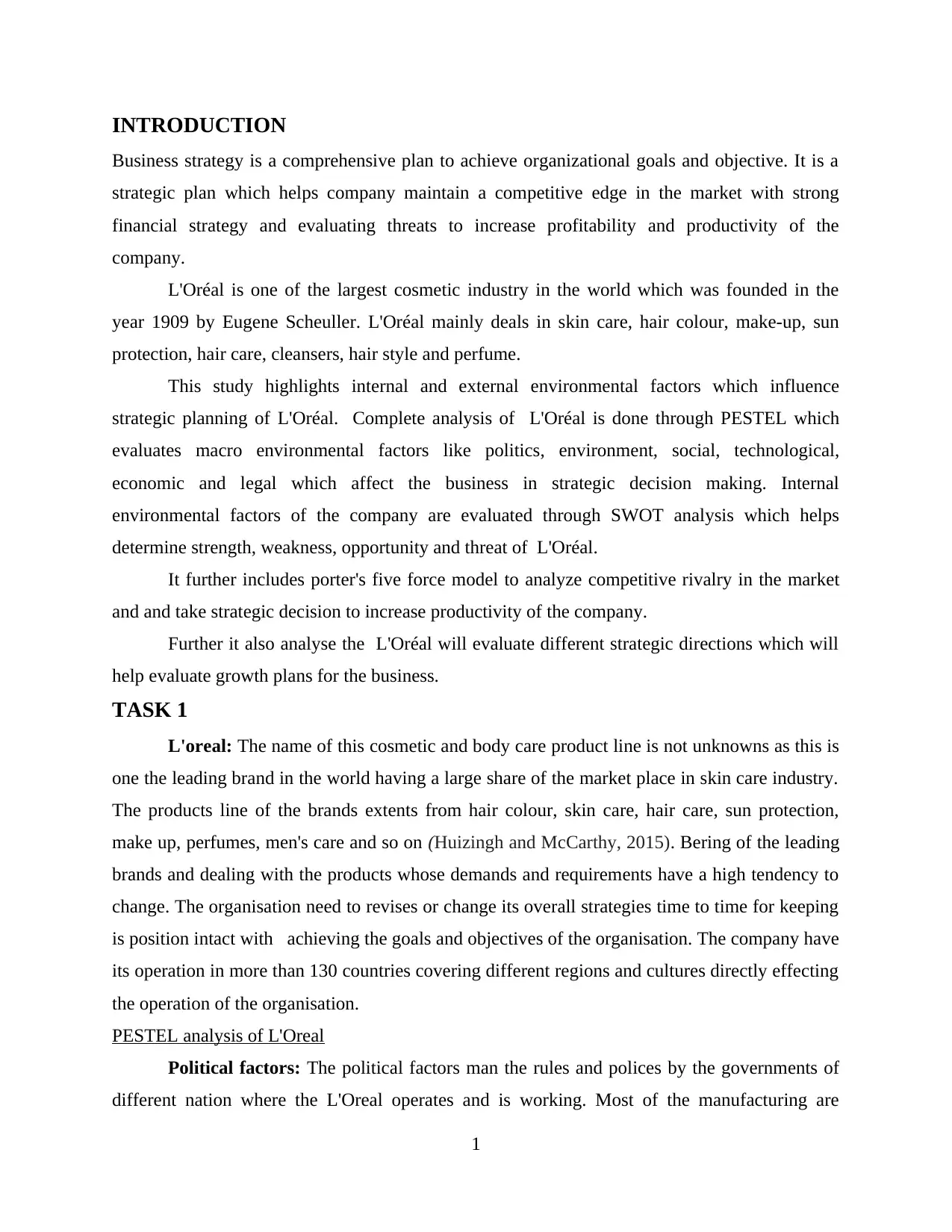
INTRODUCTION
Business strategy is a comprehensive plan to achieve organizational goals and objective. It is a
strategic plan which helps company maintain a competitive edge in the market with strong
financial strategy and evaluating threats to increase profitability and productivity of the
company.
L'Oréal is one of the largest cosmetic industry in the world which was founded in the
year 1909 by Eugene Scheuller. L'Oréal mainly deals in skin care, hair colour, make-up, sun
protection, hair care, cleansers, hair style and perfume.
This study highlights internal and external environmental factors which influence
strategic planning of L'Oréal. Complete analysis of L'Oréal is done through PESTEL which
evaluates macro environmental factors like politics, environment, social, technological,
economic and legal which affect the business in strategic decision making. Internal
environmental factors of the company are evaluated through SWOT analysis which helps
determine strength, weakness, opportunity and threat of L'Oréal.
It further includes porter's five force model to analyze competitive rivalry in the market
and and take strategic decision to increase productivity of the company.
Further it also analyse the L'Oréal will evaluate different strategic directions which will
help evaluate growth plans for the business.
TASK 1
L'oreal: The name of this cosmetic and body care product line is not unknowns as this is
one the leading brand in the world having a large share of the market place in skin care industry.
The products line of the brands extents from hair colour, skin care, hair care, sun protection,
make up, perfumes, men's care and so on (Huizingh and McCarthy, 2015). Bering of the leading
brands and dealing with the products whose demands and requirements have a high tendency to
change. The organisation need to revises or change its overall strategies time to time for keeping
is position intact with achieving the goals and objectives of the organisation. The company have
its operation in more than 130 countries covering different regions and cultures directly effecting
the operation of the organisation.
PESTEL analysis of L'Oreal
Political factors: The political factors man the rules and polices by the governments of
different nation where the L'Oreal operates and is working. Most of the manufacturing are
1
Business strategy is a comprehensive plan to achieve organizational goals and objective. It is a
strategic plan which helps company maintain a competitive edge in the market with strong
financial strategy and evaluating threats to increase profitability and productivity of the
company.
L'Oréal is one of the largest cosmetic industry in the world which was founded in the
year 1909 by Eugene Scheuller. L'Oréal mainly deals in skin care, hair colour, make-up, sun
protection, hair care, cleansers, hair style and perfume.
This study highlights internal and external environmental factors which influence
strategic planning of L'Oréal. Complete analysis of L'Oréal is done through PESTEL which
evaluates macro environmental factors like politics, environment, social, technological,
economic and legal which affect the business in strategic decision making. Internal
environmental factors of the company are evaluated through SWOT analysis which helps
determine strength, weakness, opportunity and threat of L'Oréal.
It further includes porter's five force model to analyze competitive rivalry in the market
and and take strategic decision to increase productivity of the company.
Further it also analyse the L'Oréal will evaluate different strategic directions which will
help evaluate growth plans for the business.
TASK 1
L'oreal: The name of this cosmetic and body care product line is not unknowns as this is
one the leading brand in the world having a large share of the market place in skin care industry.
The products line of the brands extents from hair colour, skin care, hair care, sun protection,
make up, perfumes, men's care and so on (Huizingh and McCarthy, 2015). Bering of the leading
brands and dealing with the products whose demands and requirements have a high tendency to
change. The organisation need to revises or change its overall strategies time to time for keeping
is position intact with achieving the goals and objectives of the organisation. The company have
its operation in more than 130 countries covering different regions and cultures directly effecting
the operation of the organisation.
PESTEL analysis of L'Oreal
Political factors: The political factors man the rules and polices by the governments of
different nation where the L'Oreal operates and is working. Most of the manufacturing are
1
⊘ This is a preview!⊘
Do you want full access?
Subscribe today to unlock all pages.

Trusted by 1+ million students worldwide
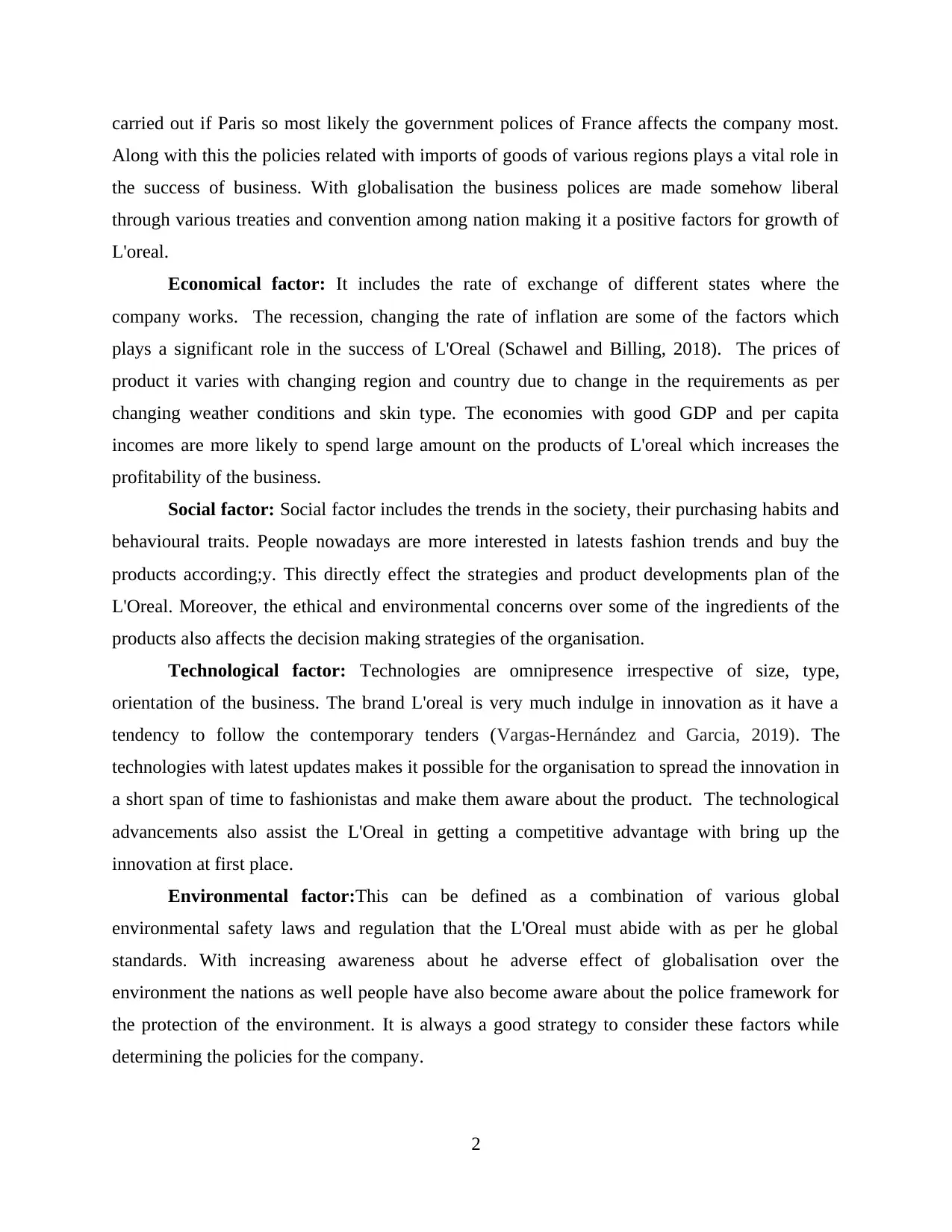
carried out if Paris so most likely the government polices of France affects the company most.
Along with this the policies related with imports of goods of various regions plays a vital role in
the success of business. With globalisation the business polices are made somehow liberal
through various treaties and convention among nation making it a positive factors for growth of
L'oreal.
Economical factor: It includes the rate of exchange of different states where the
company works. The recession, changing the rate of inflation are some of the factors which
plays a significant role in the success of L'Oreal (Schawel and Billing, 2018). The prices of
product it varies with changing region and country due to change in the requirements as per
changing weather conditions and skin type. The economies with good GDP and per capita
incomes are more likely to spend large amount on the products of L'oreal which increases the
profitability of the business.
Social factor: Social factor includes the trends in the society, their purchasing habits and
behavioural traits. People nowadays are more interested in latests fashion trends and buy the
products according;y. This directly effect the strategies and product developments plan of the
L'Oreal. Moreover, the ethical and environmental concerns over some of the ingredients of the
products also affects the decision making strategies of the organisation.
Technological factor: Technologies are omnipresence irrespective of size, type,
orientation of the business. The brand L'oreal is very much indulge in innovation as it have a
tendency to follow the contemporary tenders (Vargas-Hernández and Garcia, 2019). The
technologies with latest updates makes it possible for the organisation to spread the innovation in
a short span of time to fashionistas and make them aware about the product. The technological
advancements also assist the L'Oreal in getting a competitive advantage with bring up the
innovation at first place.
Environmental factor:This can be defined as a combination of various global
environmental safety laws and regulation that the L'Oreal must abide with as per he global
standards. With increasing awareness about he adverse effect of globalisation over the
environment the nations as well people have also become aware about the police framework for
the protection of the environment. It is always a good strategy to consider these factors while
determining the policies for the company.
2
Along with this the policies related with imports of goods of various regions plays a vital role in
the success of business. With globalisation the business polices are made somehow liberal
through various treaties and convention among nation making it a positive factors for growth of
L'oreal.
Economical factor: It includes the rate of exchange of different states where the
company works. The recession, changing the rate of inflation are some of the factors which
plays a significant role in the success of L'Oreal (Schawel and Billing, 2018). The prices of
product it varies with changing region and country due to change in the requirements as per
changing weather conditions and skin type. The economies with good GDP and per capita
incomes are more likely to spend large amount on the products of L'oreal which increases the
profitability of the business.
Social factor: Social factor includes the trends in the society, their purchasing habits and
behavioural traits. People nowadays are more interested in latests fashion trends and buy the
products according;y. This directly effect the strategies and product developments plan of the
L'Oreal. Moreover, the ethical and environmental concerns over some of the ingredients of the
products also affects the decision making strategies of the organisation.
Technological factor: Technologies are omnipresence irrespective of size, type,
orientation of the business. The brand L'oreal is very much indulge in innovation as it have a
tendency to follow the contemporary tenders (Vargas-Hernández and Garcia, 2019). The
technologies with latest updates makes it possible for the organisation to spread the innovation in
a short span of time to fashionistas and make them aware about the product. The technological
advancements also assist the L'Oreal in getting a competitive advantage with bring up the
innovation at first place.
Environmental factor:This can be defined as a combination of various global
environmental safety laws and regulation that the L'Oreal must abide with as per he global
standards. With increasing awareness about he adverse effect of globalisation over the
environment the nations as well people have also become aware about the police framework for
the protection of the environment. It is always a good strategy to consider these factors while
determining the policies for the company.
2
Paraphrase This Document
Need a fresh take? Get an instant paraphrase of this document with our AI Paraphraser
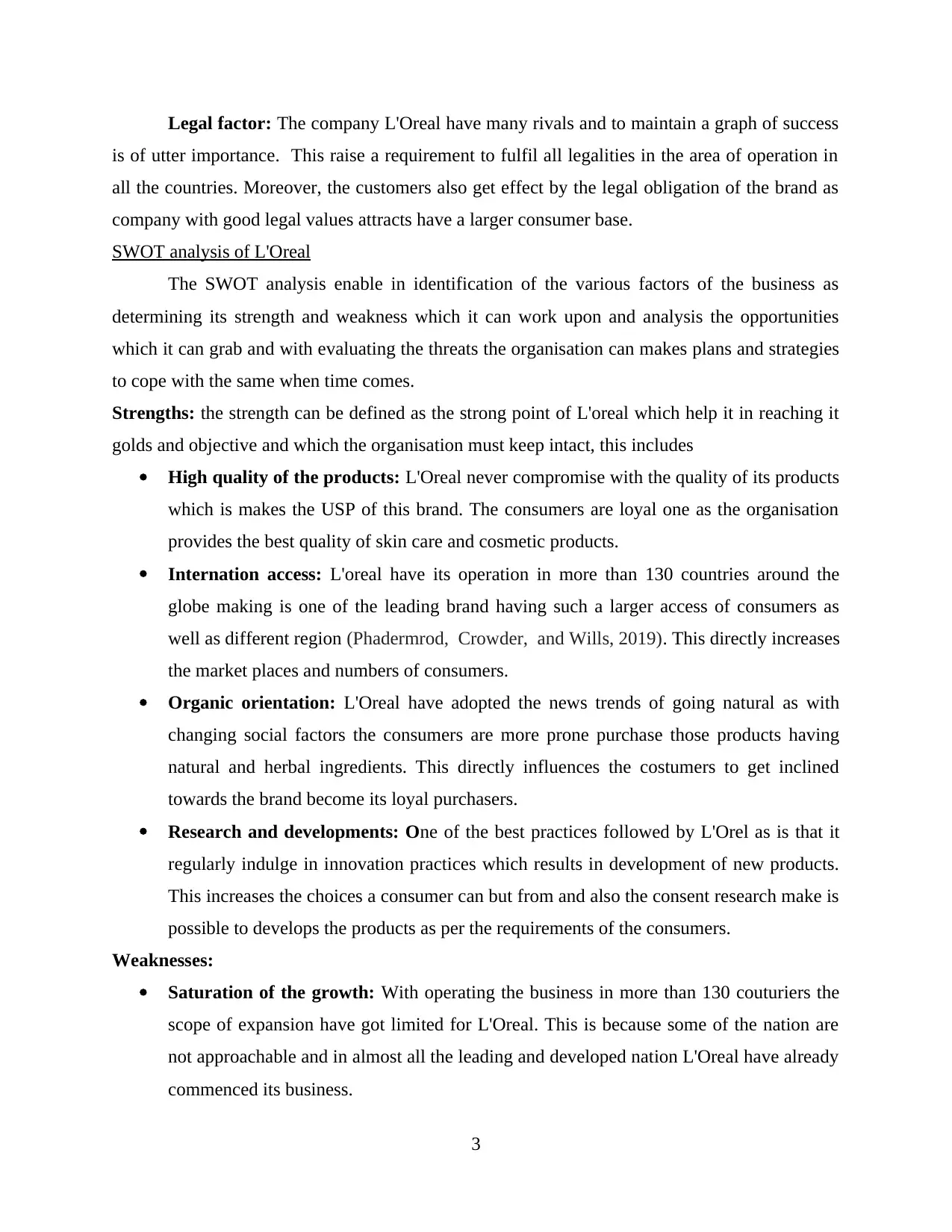
Legal factor: The company L'Oreal have many rivals and to maintain a graph of success
is of utter importance. This raise a requirement to fulfil all legalities in the area of operation in
all the countries. Moreover, the customers also get effect by the legal obligation of the brand as
company with good legal values attracts have a larger consumer base.
SWOT analysis of L'Oreal
The SWOT analysis enable in identification of the various factors of the business as
determining its strength and weakness which it can work upon and analysis the opportunities
which it can grab and with evaluating the threats the organisation can makes plans and strategies
to cope with the same when time comes.
Strengths: the strength can be defined as the strong point of L'oreal which help it in reaching it
golds and objective and which the organisation must keep intact, this includes
High quality of the products: L'Oreal never compromise with the quality of its products
which is makes the USP of this brand. The consumers are loyal one as the organisation
provides the best quality of skin care and cosmetic products.
Internation access: L'oreal have its operation in more than 130 countries around the
globe making is one of the leading brand having such a larger access of consumers as
well as different region (Phadermrod, Crowder, and Wills, 2019). This directly increases
the market places and numbers of consumers.
Organic orientation: L'Oreal have adopted the news trends of going natural as with
changing social factors the consumers are more prone purchase those products having
natural and herbal ingredients. This directly influences the costumers to get inclined
towards the brand become its loyal purchasers.
Research and developments: One of the best practices followed by L'Orel as is that it
regularly indulge in innovation practices which results in development of new products.
This increases the choices a consumer can but from and also the consent research make is
possible to develops the products as per the requirements of the consumers.
Weaknesses:
Saturation of the growth: With operating the business in more than 130 couturiers the
scope of expansion have got limited for L'Oreal. This is because some of the nation are
not approachable and in almost all the leading and developed nation L'Oreal have already
commenced its business.
3
is of utter importance. This raise a requirement to fulfil all legalities in the area of operation in
all the countries. Moreover, the customers also get effect by the legal obligation of the brand as
company with good legal values attracts have a larger consumer base.
SWOT analysis of L'Oreal
The SWOT analysis enable in identification of the various factors of the business as
determining its strength and weakness which it can work upon and analysis the opportunities
which it can grab and with evaluating the threats the organisation can makes plans and strategies
to cope with the same when time comes.
Strengths: the strength can be defined as the strong point of L'oreal which help it in reaching it
golds and objective and which the organisation must keep intact, this includes
High quality of the products: L'Oreal never compromise with the quality of its products
which is makes the USP of this brand. The consumers are loyal one as the organisation
provides the best quality of skin care and cosmetic products.
Internation access: L'oreal have its operation in more than 130 countries around the
globe making is one of the leading brand having such a larger access of consumers as
well as different region (Phadermrod, Crowder, and Wills, 2019). This directly increases
the market places and numbers of consumers.
Organic orientation: L'Oreal have adopted the news trends of going natural as with
changing social factors the consumers are more prone purchase those products having
natural and herbal ingredients. This directly influences the costumers to get inclined
towards the brand become its loyal purchasers.
Research and developments: One of the best practices followed by L'Orel as is that it
regularly indulge in innovation practices which results in development of new products.
This increases the choices a consumer can but from and also the consent research make is
possible to develops the products as per the requirements of the consumers.
Weaknesses:
Saturation of the growth: With operating the business in more than 130 couturiers the
scope of expansion have got limited for L'Oreal. This is because some of the nation are
not approachable and in almost all the leading and developed nation L'Oreal have already
commenced its business.
3
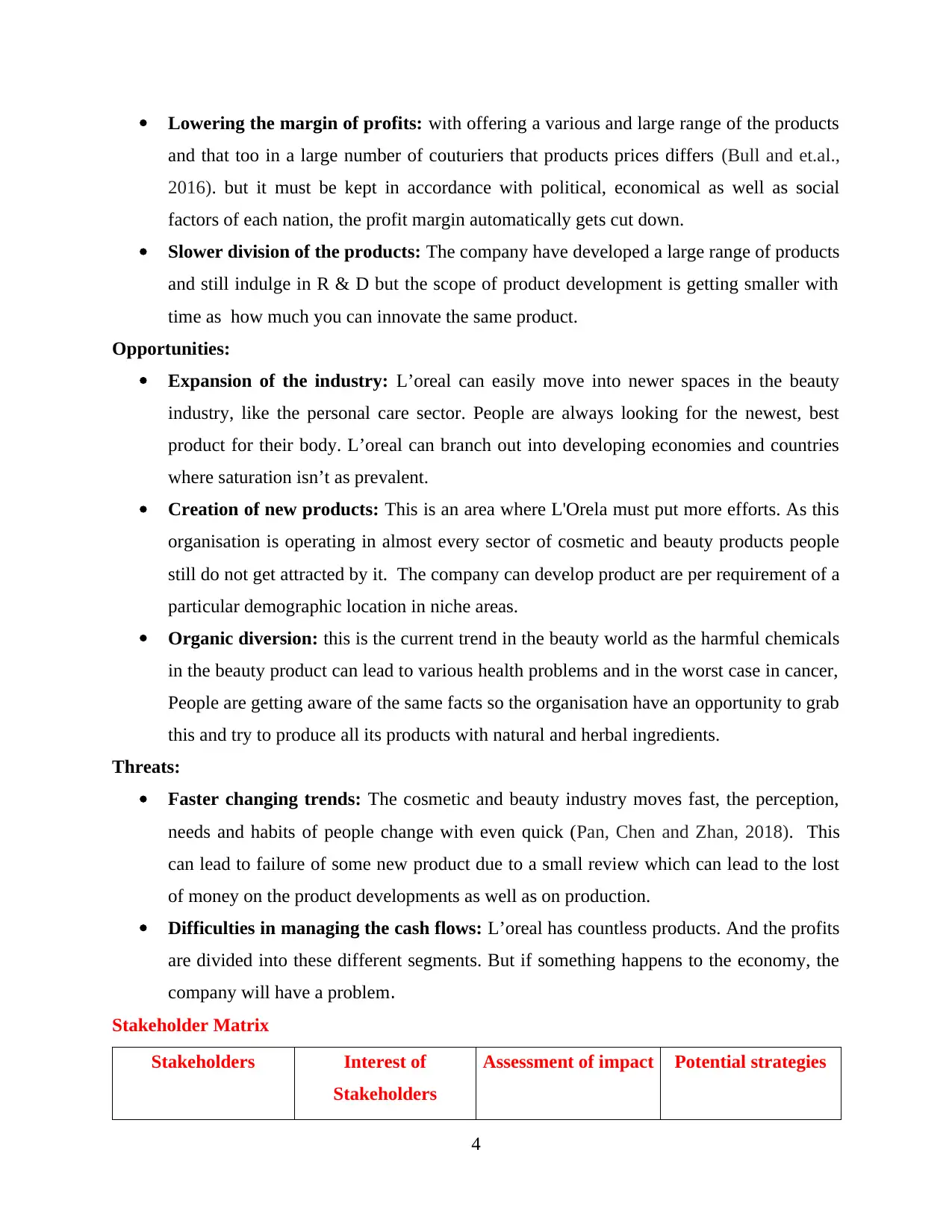
Lowering the margin of profits: with offering a various and large range of the products
and that too in a large number of couturiers that products prices differs (Bull and et.al.,
2016). but it must be kept in accordance with political, economical as well as social
factors of each nation, the profit margin automatically gets cut down.
Slower division of the products: The company have developed a large range of products
and still indulge in R & D but the scope of product development is getting smaller with
time as how much you can innovate the same product.
Opportunities:
Expansion of the industry: L’oreal can easily move into newer spaces in the beauty
industry, like the personal care sector. People are always looking for the newest, best
product for their body. L’oreal can branch out into developing economies and countries
where saturation isn’t as prevalent.
Creation of new products: This is an area where L'Orela must put more efforts. As this
organisation is operating in almost every sector of cosmetic and beauty products people
still do not get attracted by it. The company can develop product are per requirement of a
particular demographic location in niche areas.
Organic diversion: this is the current trend in the beauty world as the harmful chemicals
in the beauty product can lead to various health problems and in the worst case in cancer,
People are getting aware of the same facts so the organisation have an opportunity to grab
this and try to produce all its products with natural and herbal ingredients.
Threats:
Faster changing trends: The cosmetic and beauty industry moves fast, the perception,
needs and habits of people change with even quick (Pan, Chen and Zhan, 2018). This
can lead to failure of some new product due to a small review which can lead to the lost
of money on the product developments as well as on production.
Difficulties in managing the cash flows: L’oreal has countless products. And the profits
are divided into these different segments. But if something happens to the economy, the
company will have a problem.
Stakeholder Matrix
Stakeholders Interest of
Stakeholders
Assessment of impact Potential strategies
4
and that too in a large number of couturiers that products prices differs (Bull and et.al.,
2016). but it must be kept in accordance with political, economical as well as social
factors of each nation, the profit margin automatically gets cut down.
Slower division of the products: The company have developed a large range of products
and still indulge in R & D but the scope of product development is getting smaller with
time as how much you can innovate the same product.
Opportunities:
Expansion of the industry: L’oreal can easily move into newer spaces in the beauty
industry, like the personal care sector. People are always looking for the newest, best
product for their body. L’oreal can branch out into developing economies and countries
where saturation isn’t as prevalent.
Creation of new products: This is an area where L'Orela must put more efforts. As this
organisation is operating in almost every sector of cosmetic and beauty products people
still do not get attracted by it. The company can develop product are per requirement of a
particular demographic location in niche areas.
Organic diversion: this is the current trend in the beauty world as the harmful chemicals
in the beauty product can lead to various health problems and in the worst case in cancer,
People are getting aware of the same facts so the organisation have an opportunity to grab
this and try to produce all its products with natural and herbal ingredients.
Threats:
Faster changing trends: The cosmetic and beauty industry moves fast, the perception,
needs and habits of people change with even quick (Pan, Chen and Zhan, 2018). This
can lead to failure of some new product due to a small review which can lead to the lost
of money on the product developments as well as on production.
Difficulties in managing the cash flows: L’oreal has countless products. And the profits
are divided into these different segments. But if something happens to the economy, the
company will have a problem.
Stakeholder Matrix
Stakeholders Interest of
Stakeholders
Assessment of impact Potential strategies
4
⊘ This is a preview!⊘
Do you want full access?
Subscribe today to unlock all pages.

Trusted by 1+ million students worldwide
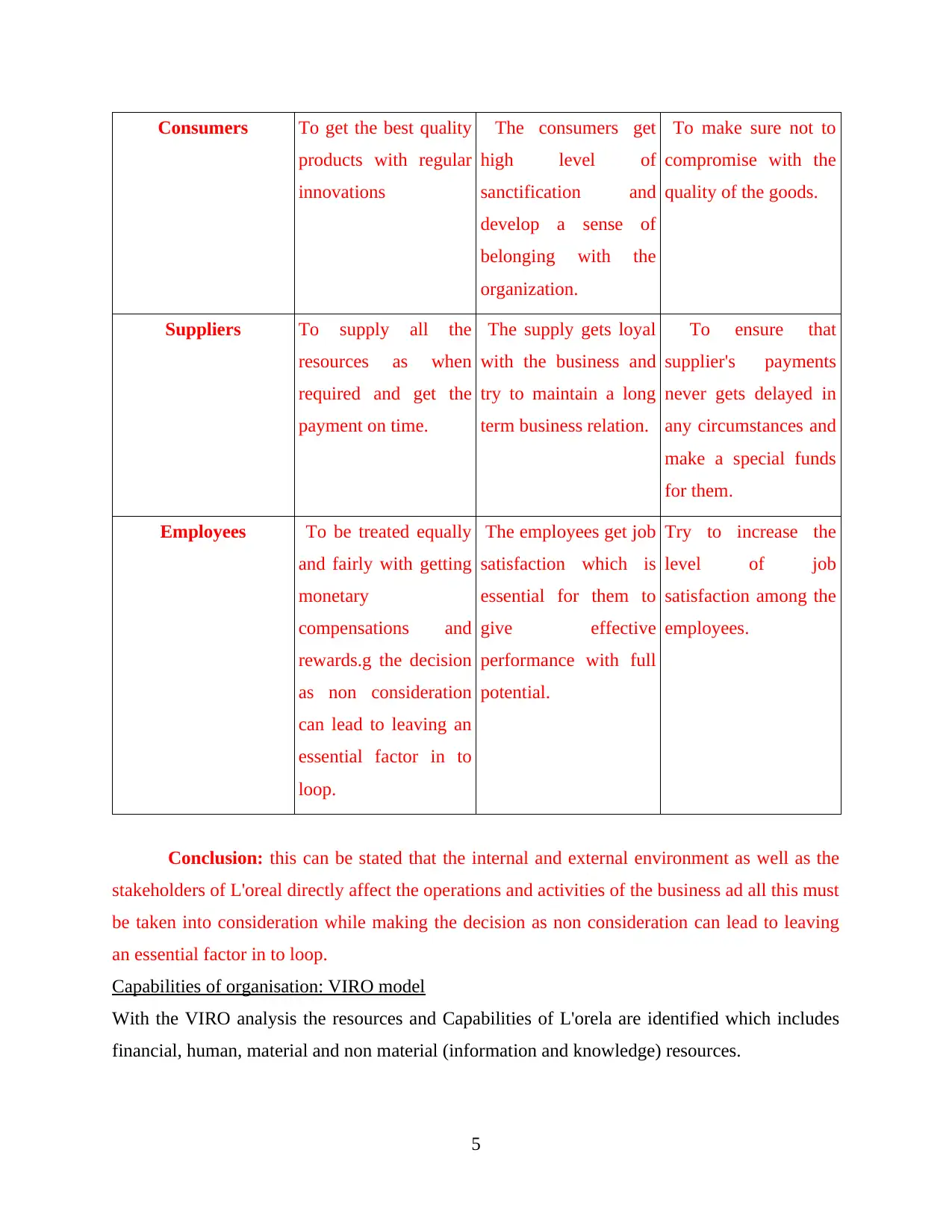
Consumers To get the best quality
products with regular
innovations
The consumers get
high level of
sanctification and
develop a sense of
belonging with the
organization.
To make sure not to
compromise with the
quality of the goods.
Suppliers To supply all the
resources as when
required and get the
payment on time.
The supply gets loyal
with the business and
try to maintain a long
term business relation.
To ensure that
supplier's payments
never gets delayed in
any circumstances and
make a special funds
for them.
Employees To be treated equally
and fairly with getting
monetary
compensations and
rewards.g the decision
as non consideration
can lead to leaving an
essential factor in to
loop.
The employees get job
satisfaction which is
essential for them to
give effective
performance with full
potential.
Try to increase the
level of job
satisfaction among the
employees.
Conclusion: this can be stated that the internal and external environment as well as the
stakeholders of L'oreal directly affect the operations and activities of the business ad all this must
be taken into consideration while making the decision as non consideration can lead to leaving
an essential factor in to loop.
Capabilities of organisation: VIRO model
With the VIRO analysis the resources and Capabilities of L'orela are identified which includes
financial, human, material and non material (information and knowledge) resources.
5
products with regular
innovations
The consumers get
high level of
sanctification and
develop a sense of
belonging with the
organization.
To make sure not to
compromise with the
quality of the goods.
Suppliers To supply all the
resources as when
required and get the
payment on time.
The supply gets loyal
with the business and
try to maintain a long
term business relation.
To ensure that
supplier's payments
never gets delayed in
any circumstances and
make a special funds
for them.
Employees To be treated equally
and fairly with getting
monetary
compensations and
rewards.g the decision
as non consideration
can lead to leaving an
essential factor in to
loop.
The employees get job
satisfaction which is
essential for them to
give effective
performance with full
potential.
Try to increase the
level of job
satisfaction among the
employees.
Conclusion: this can be stated that the internal and external environment as well as the
stakeholders of L'oreal directly affect the operations and activities of the business ad all this must
be taken into consideration while making the decision as non consideration can lead to leaving
an essential factor in to loop.
Capabilities of organisation: VIRO model
With the VIRO analysis the resources and Capabilities of L'orela are identified which includes
financial, human, material and non material (information and knowledge) resources.
5
Paraphrase This Document
Need a fresh take? Get an instant paraphrase of this document with our AI Paraphraser
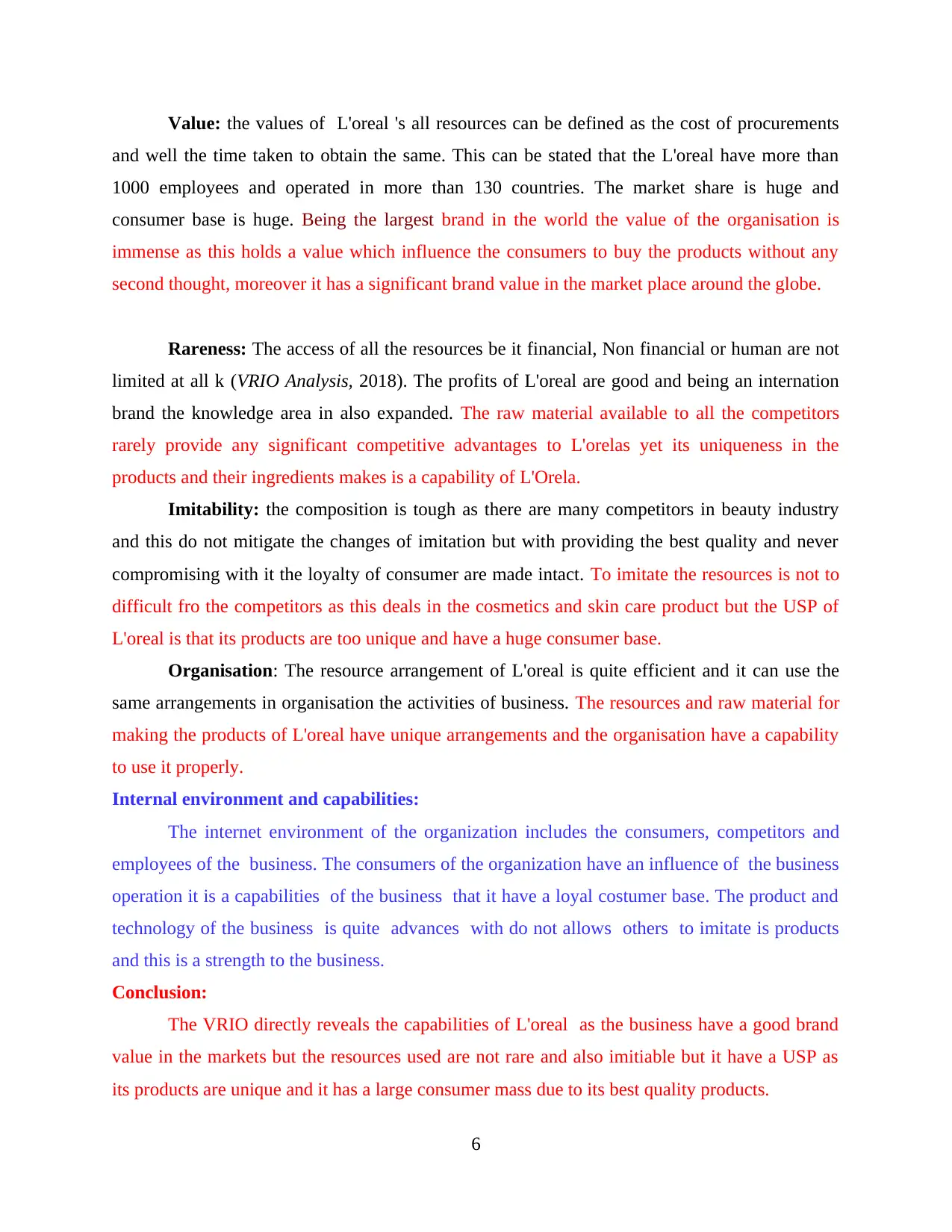
Value: the values of L'oreal 's all resources can be defined as the cost of procurements
and well the time taken to obtain the same. This can be stated that the L'oreal have more than
1000 employees and operated in more than 130 countries. The market share is huge and
consumer base is huge. Being the largest brand in the world the value of the organisation is
immense as this holds a value which influence the consumers to buy the products without any
second thought, moreover it has a significant brand value in the market place around the globe.
Rareness: The access of all the resources be it financial, Non financial or human are not
limited at all k (VRIO Analysis, 2018). The profits of L'oreal are good and being an internation
brand the knowledge area in also expanded. The raw material available to all the competitors
rarely provide any significant competitive advantages to L'orelas yet its uniqueness in the
products and their ingredients makes is a capability of L'Orela.
Imitability: the composition is tough as there are many competitors in beauty industry
and this do not mitigate the changes of imitation but with providing the best quality and never
compromising with it the loyalty of consumer are made intact. To imitate the resources is not to
difficult fro the competitors as this deals in the cosmetics and skin care product but the USP of
L'oreal is that its products are too unique and have a huge consumer base.
Organisation: The resource arrangement of L'oreal is quite efficient and it can use the
same arrangements in organisation the activities of business. The resources and raw material for
making the products of L'oreal have unique arrangements and the organisation have a capability
to use it properly.
Internal environment and capabilities:
The internet environment of the organization includes the consumers, competitors and
employees of the business. The consumers of the organization have an influence of the business
operation it is a capabilities of the business that it have a loyal costumer base. The product and
technology of the business is quite advances with do not allows others to imitate is products
and this is a strength to the business.
Conclusion:
The VRIO directly reveals the capabilities of L'oreal as the business have a good brand
value in the markets but the resources used are not rare and also imitiable but it have a USP as
its products are unique and it has a large consumer mass due to its best quality products.
6
and well the time taken to obtain the same. This can be stated that the L'oreal have more than
1000 employees and operated in more than 130 countries. The market share is huge and
consumer base is huge. Being the largest brand in the world the value of the organisation is
immense as this holds a value which influence the consumers to buy the products without any
second thought, moreover it has a significant brand value in the market place around the globe.
Rareness: The access of all the resources be it financial, Non financial or human are not
limited at all k (VRIO Analysis, 2018). The profits of L'oreal are good and being an internation
brand the knowledge area in also expanded. The raw material available to all the competitors
rarely provide any significant competitive advantages to L'orelas yet its uniqueness in the
products and their ingredients makes is a capability of L'Orela.
Imitability: the composition is tough as there are many competitors in beauty industry
and this do not mitigate the changes of imitation but with providing the best quality and never
compromising with it the loyalty of consumer are made intact. To imitate the resources is not to
difficult fro the competitors as this deals in the cosmetics and skin care product but the USP of
L'oreal is that its products are too unique and have a huge consumer base.
Organisation: The resource arrangement of L'oreal is quite efficient and it can use the
same arrangements in organisation the activities of business. The resources and raw material for
making the products of L'oreal have unique arrangements and the organisation have a capability
to use it properly.
Internal environment and capabilities:
The internet environment of the organization includes the consumers, competitors and
employees of the business. The consumers of the organization have an influence of the business
operation it is a capabilities of the business that it have a loyal costumer base. The product and
technology of the business is quite advances with do not allows others to imitate is products
and this is a strength to the business.
Conclusion:
The VRIO directly reveals the capabilities of L'oreal as the business have a good brand
value in the markets but the resources used are not rare and also imitiable but it have a USP as
its products are unique and it has a large consumer mass due to its best quality products.
6
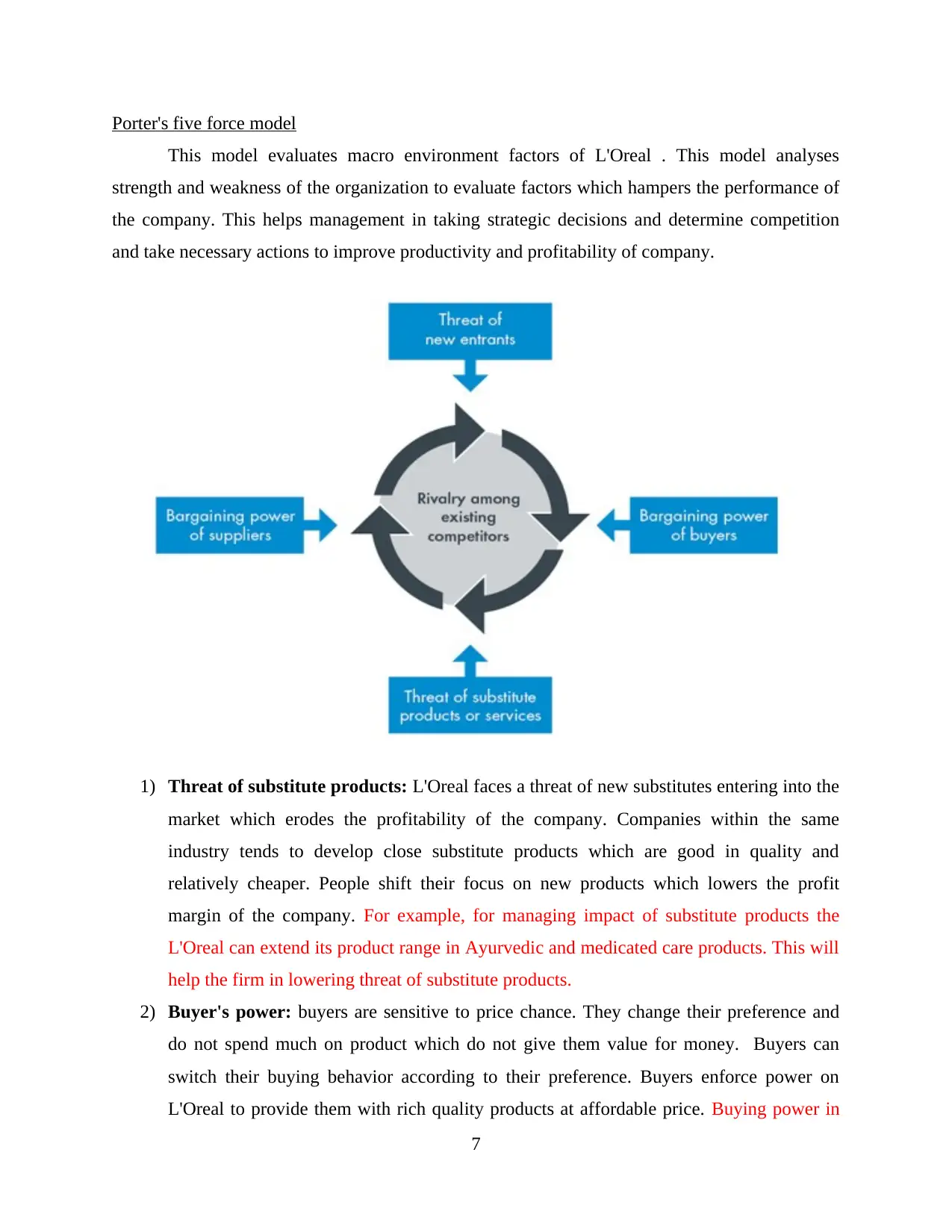
Porter's five force model
This model evaluates macro environment factors of L'Oreal . This model analyses
strength and weakness of the organization to evaluate factors which hampers the performance of
the company. This helps management in taking strategic decisions and determine competition
and take necessary actions to improve productivity and profitability of company.
1) Threat of substitute products: L'Oreal faces a threat of new substitutes entering into the
market which erodes the profitability of the company. Companies within the same
industry tends to develop close substitute products which are good in quality and
relatively cheaper. People shift their focus on new products which lowers the profit
margin of the company. For example, for managing impact of substitute products the
L'Oreal can extend its product range in Ayurvedic and medicated care products. This will
help the firm in lowering threat of substitute products.
2) Buyer's power: buyers are sensitive to price chance. They change their preference and
do not spend much on product which do not give them value for money. Buyers can
switch their buying behavior according to their preference. Buyers enforce power on
L'Oreal to provide them with rich quality products at affordable price. Buying power in
7
This model evaluates macro environment factors of L'Oreal . This model analyses
strength and weakness of the organization to evaluate factors which hampers the performance of
the company. This helps management in taking strategic decisions and determine competition
and take necessary actions to improve productivity and profitability of company.
1) Threat of substitute products: L'Oreal faces a threat of new substitutes entering into the
market which erodes the profitability of the company. Companies within the same
industry tends to develop close substitute products which are good in quality and
relatively cheaper. People shift their focus on new products which lowers the profit
margin of the company. For example, for managing impact of substitute products the
L'Oreal can extend its product range in Ayurvedic and medicated care products. This will
help the firm in lowering threat of substitute products.
2) Buyer's power: buyers are sensitive to price chance. They change their preference and
do not spend much on product which do not give them value for money. Buyers can
switch their buying behavior according to their preference. Buyers enforce power on
L'Oreal to provide them with rich quality products at affordable price. Buying power in
7
⊘ This is a preview!⊘
Do you want full access?
Subscribe today to unlock all pages.

Trusted by 1+ million students worldwide
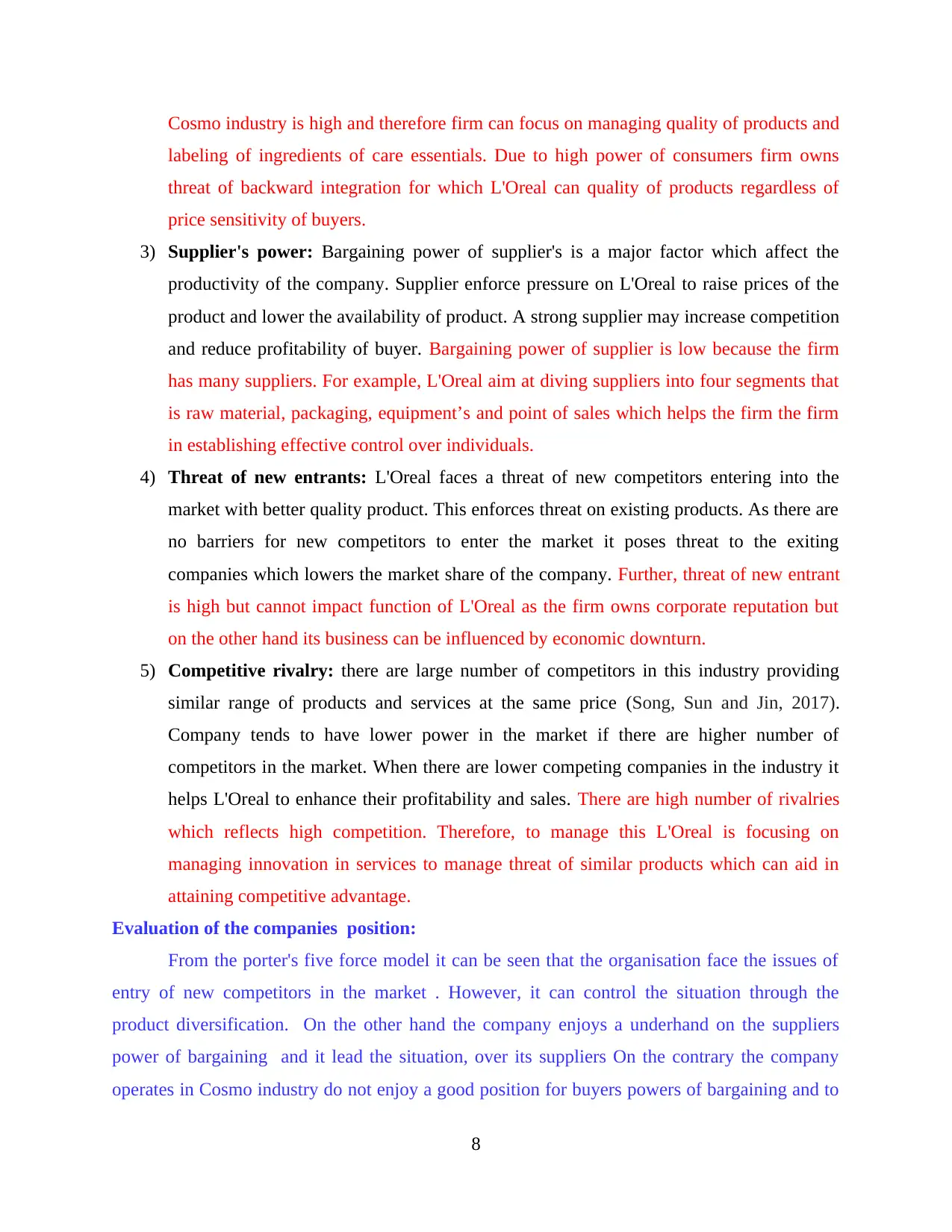
Cosmo industry is high and therefore firm can focus on managing quality of products and
labeling of ingredients of care essentials. Due to high power of consumers firm owns
threat of backward integration for which L'Oreal can quality of products regardless of
price sensitivity of buyers.
3) Supplier's power: Bargaining power of supplier's is a major factor which affect the
productivity of the company. Supplier enforce pressure on L'Oreal to raise prices of the
product and lower the availability of product. A strong supplier may increase competition
and reduce profitability of buyer. Bargaining power of supplier is low because the firm
has many suppliers. For example, L'Oreal aim at diving suppliers into four segments that
is raw material, packaging, equipment’s and point of sales which helps the firm the firm
in establishing effective control over individuals.
4) Threat of new entrants: L'Oreal faces a threat of new competitors entering into the
market with better quality product. This enforces threat on existing products. As there are
no barriers for new competitors to enter the market it poses threat to the exiting
companies which lowers the market share of the company. Further, threat of new entrant
is high but cannot impact function of L'Oreal as the firm owns corporate reputation but
on the other hand its business can be influenced by economic downturn.
5) Competitive rivalry: there are large number of competitors in this industry providing
similar range of products and services at the same price (Song, Sun and Jin, 2017).
Company tends to have lower power in the market if there are higher number of
competitors in the market. When there are lower competing companies in the industry it
helps L'Oreal to enhance their profitability and sales. There are high number of rivalries
which reflects high competition. Therefore, to manage this L'Oreal is focusing on
managing innovation in services to manage threat of similar products which can aid in
attaining competitive advantage.
Evaluation of the companies position:
From the porter's five force model it can be seen that the organisation face the issues of
entry of new competitors in the market . However, it can control the situation through the
product diversification. On the other hand the company enjoys a underhand on the suppliers
power of bargaining and it lead the situation, over its suppliers On the contrary the company
operates in Cosmo industry do not enjoy a good position for buyers powers of bargaining and to
8
labeling of ingredients of care essentials. Due to high power of consumers firm owns
threat of backward integration for which L'Oreal can quality of products regardless of
price sensitivity of buyers.
3) Supplier's power: Bargaining power of supplier's is a major factor which affect the
productivity of the company. Supplier enforce pressure on L'Oreal to raise prices of the
product and lower the availability of product. A strong supplier may increase competition
and reduce profitability of buyer. Bargaining power of supplier is low because the firm
has many suppliers. For example, L'Oreal aim at diving suppliers into four segments that
is raw material, packaging, equipment’s and point of sales which helps the firm the firm
in establishing effective control over individuals.
4) Threat of new entrants: L'Oreal faces a threat of new competitors entering into the
market with better quality product. This enforces threat on existing products. As there are
no barriers for new competitors to enter the market it poses threat to the exiting
companies which lowers the market share of the company. Further, threat of new entrant
is high but cannot impact function of L'Oreal as the firm owns corporate reputation but
on the other hand its business can be influenced by economic downturn.
5) Competitive rivalry: there are large number of competitors in this industry providing
similar range of products and services at the same price (Song, Sun and Jin, 2017).
Company tends to have lower power in the market if there are higher number of
competitors in the market. When there are lower competing companies in the industry it
helps L'Oreal to enhance their profitability and sales. There are high number of rivalries
which reflects high competition. Therefore, to manage this L'Oreal is focusing on
managing innovation in services to manage threat of similar products which can aid in
attaining competitive advantage.
Evaluation of the companies position:
From the porter's five force model it can be seen that the organisation face the issues of
entry of new competitors in the market . However, it can control the situation through the
product diversification. On the other hand the company enjoys a underhand on the suppliers
power of bargaining and it lead the situation, over its suppliers On the contrary the company
operates in Cosmo industry do not enjoy a good position for buyers powers of bargaining and to
8
Paraphrase This Document
Need a fresh take? Get an instant paraphrase of this document with our AI Paraphraser
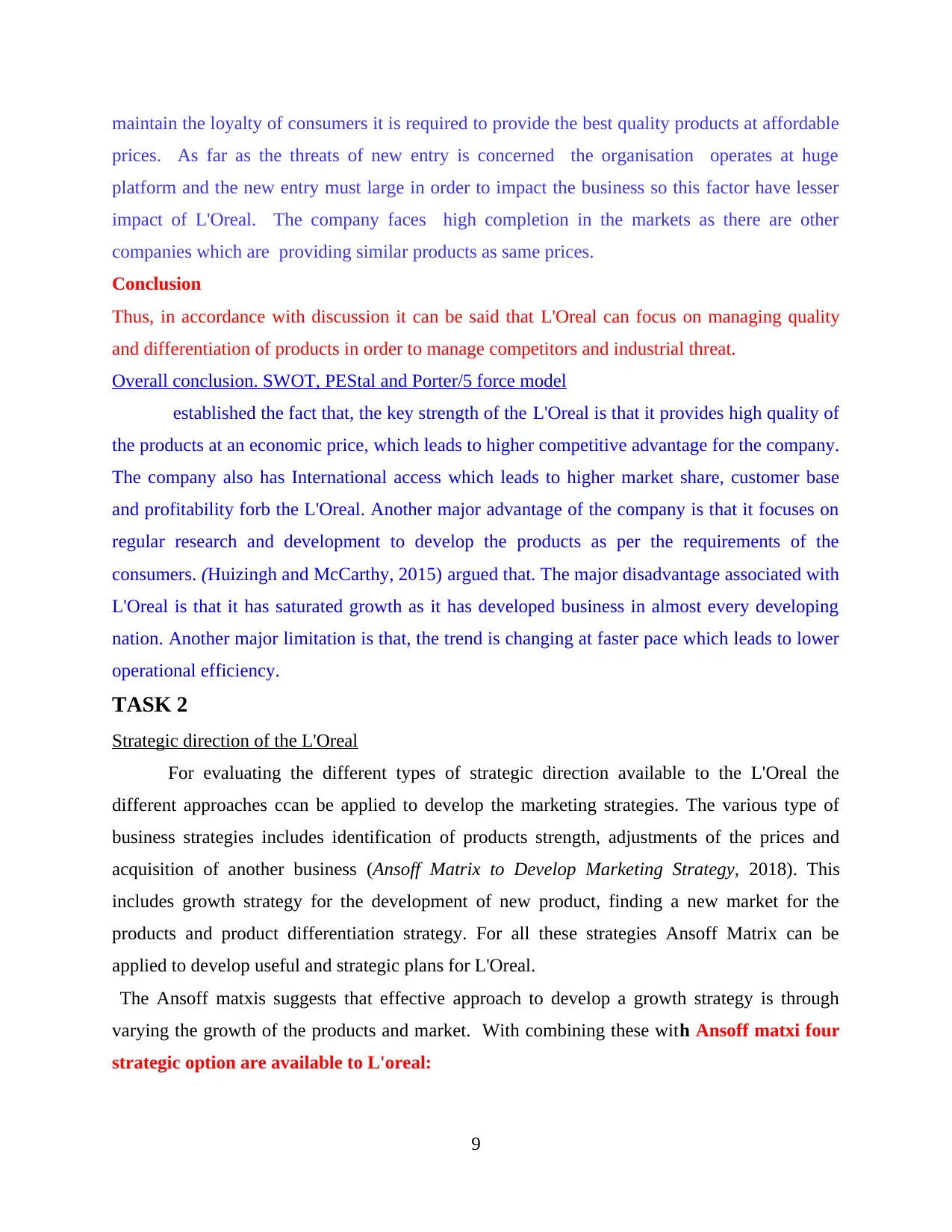
maintain the loyalty of consumers it is required to provide the best quality products at affordable
prices. As far as the threats of new entry is concerned the organisation operates at huge
platform and the new entry must large in order to impact the business so this factor have lesser
impact of L'Oreal. The company faces high completion in the markets as there are other
companies which are providing similar products as same prices.
Conclusion
Thus, in accordance with discussion it can be said that L'Oreal can focus on managing quality
and differentiation of products in order to manage competitors and industrial threat.
Overall conclusion. SWOT, PEStal and Porter/5 force model
established the fact that, the key strength of the L'Oreal is that it provides high quality of
the products at an economic price, which leads to higher competitive advantage for the company.
The company also has International access which leads to higher market share, customer base
and profitability forb the L'Oreal. Another major advantage of the company is that it focuses on
regular research and development to develop the products as per the requirements of the
consumers. (Huizingh and McCarthy, 2015) argued that. The major disadvantage associated with
L'Oreal is that it has saturated growth as it has developed business in almost every developing
nation. Another major limitation is that, the trend is changing at faster pace which leads to lower
operational efficiency.
TASK 2
Strategic direction of the L'Oreal
For evaluating the different types of strategic direction available to the L'Oreal the
different approaches ccan be applied to develop the marketing strategies. The various type of
business strategies includes identification of products strength, adjustments of the prices and
acquisition of another business (Ansoff Matrix to Develop Marketing Strategy, 2018). This
includes growth strategy for the development of new product, finding a new market for the
products and product differentiation strategy. For all these strategies Ansoff Matrix can be
applied to develop useful and strategic plans for L'Oreal.
The Ansoff matxis suggests that effective approach to develop a growth strategy is through
varying the growth of the products and market. With combining these with Ansoff matxi four
strategic option are available to L'oreal:
9
prices. As far as the threats of new entry is concerned the organisation operates at huge
platform and the new entry must large in order to impact the business so this factor have lesser
impact of L'Oreal. The company faces high completion in the markets as there are other
companies which are providing similar products as same prices.
Conclusion
Thus, in accordance with discussion it can be said that L'Oreal can focus on managing quality
and differentiation of products in order to manage competitors and industrial threat.
Overall conclusion. SWOT, PEStal and Porter/5 force model
established the fact that, the key strength of the L'Oreal is that it provides high quality of
the products at an economic price, which leads to higher competitive advantage for the company.
The company also has International access which leads to higher market share, customer base
and profitability forb the L'Oreal. Another major advantage of the company is that it focuses on
regular research and development to develop the products as per the requirements of the
consumers. (Huizingh and McCarthy, 2015) argued that. The major disadvantage associated with
L'Oreal is that it has saturated growth as it has developed business in almost every developing
nation. Another major limitation is that, the trend is changing at faster pace which leads to lower
operational efficiency.
TASK 2
Strategic direction of the L'Oreal
For evaluating the different types of strategic direction available to the L'Oreal the
different approaches ccan be applied to develop the marketing strategies. The various type of
business strategies includes identification of products strength, adjustments of the prices and
acquisition of another business (Ansoff Matrix to Develop Marketing Strategy, 2018). This
includes growth strategy for the development of new product, finding a new market for the
products and product differentiation strategy. For all these strategies Ansoff Matrix can be
applied to develop useful and strategic plans for L'Oreal.
The Ansoff matxis suggests that effective approach to develop a growth strategy is through
varying the growth of the products and market. With combining these with Ansoff matxi four
strategic option are available to L'oreal:
9
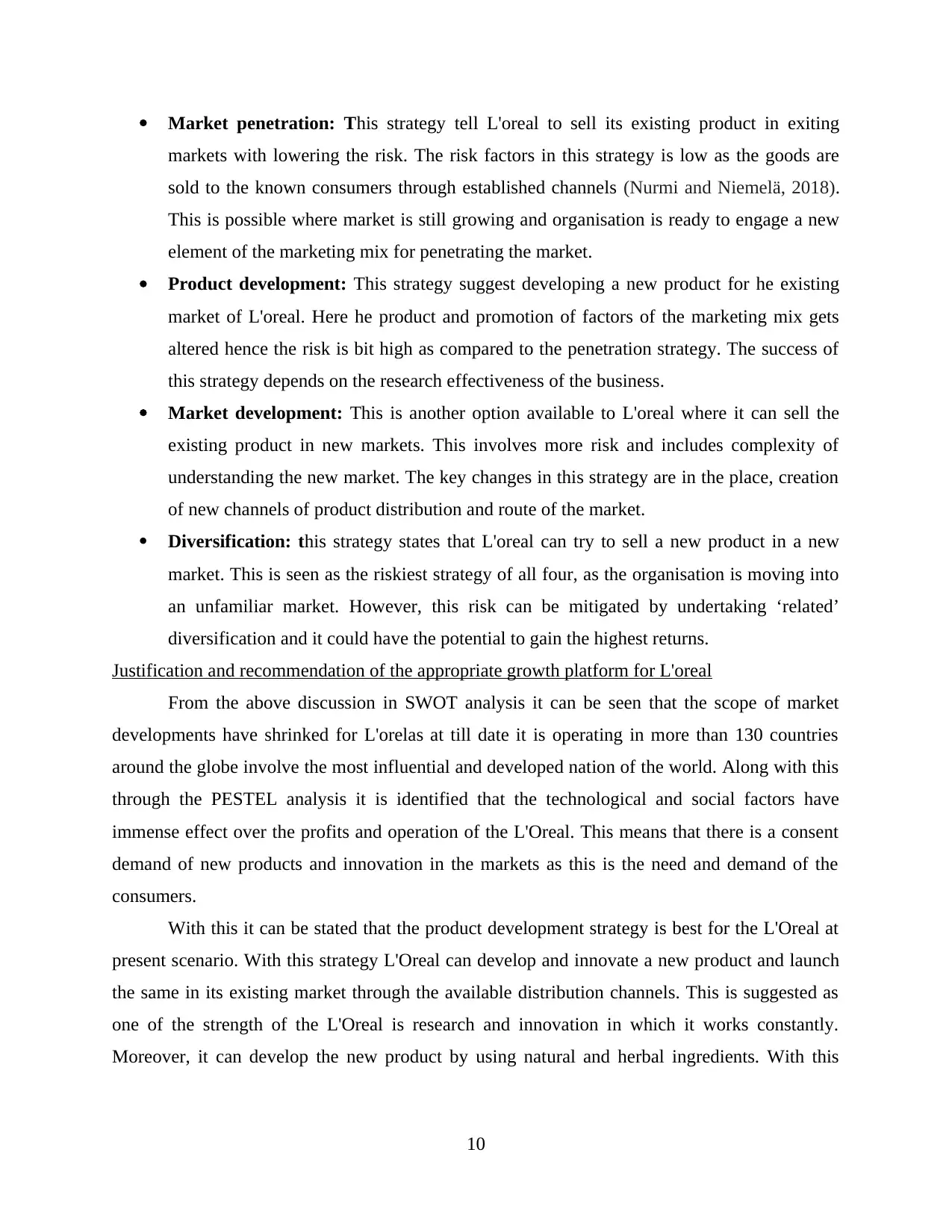
Market penetration: This strategy tell L'oreal to sell its existing product in exiting
markets with lowering the risk. The risk factors in this strategy is low as the goods are
sold to the known consumers through established channels (Nurmi and Niemelä, 2018).
This is possible where market is still growing and organisation is ready to engage a new
element of the marketing mix for penetrating the market.
Product development: This strategy suggest developing a new product for he existing
market of L'oreal. Here he product and promotion of factors of the marketing mix gets
altered hence the risk is bit high as compared to the penetration strategy. The success of
this strategy depends on the research effectiveness of the business.
Market development: This is another option available to L'oreal where it can sell the
existing product in new markets. This involves more risk and includes complexity of
understanding the new market. The key changes in this strategy are in the place, creation
of new channels of product distribution and route of the market.
Diversification: this strategy states that L'oreal can try to sell a new product in a new
market. This is seen as the riskiest strategy of all four, as the organisation is moving into
an unfamiliar market. However, this risk can be mitigated by undertaking ‘related’
diversification and it could have the potential to gain the highest returns.
Justification and recommendation of the appropriate growth platform for L'oreal
From the above discussion in SWOT analysis it can be seen that the scope of market
developments have shrinked for L'orelas at till date it is operating in more than 130 countries
around the globe involve the most influential and developed nation of the world. Along with this
through the PESTEL analysis it is identified that the technological and social factors have
immense effect over the profits and operation of the L'Oreal. This means that there is a consent
demand of new products and innovation in the markets as this is the need and demand of the
consumers.
With this it can be stated that the product development strategy is best for the L'Oreal at
present scenario. With this strategy L'Oreal can develop and innovate a new product and launch
the same in its existing market through the available distribution channels. This is suggested as
one of the strength of the L'Oreal is research and innovation in which it works constantly.
Moreover, it can develop the new product by using natural and herbal ingredients. With this
10
markets with lowering the risk. The risk factors in this strategy is low as the goods are
sold to the known consumers through established channels (Nurmi and Niemelä, 2018).
This is possible where market is still growing and organisation is ready to engage a new
element of the marketing mix for penetrating the market.
Product development: This strategy suggest developing a new product for he existing
market of L'oreal. Here he product and promotion of factors of the marketing mix gets
altered hence the risk is bit high as compared to the penetration strategy. The success of
this strategy depends on the research effectiveness of the business.
Market development: This is another option available to L'oreal where it can sell the
existing product in new markets. This involves more risk and includes complexity of
understanding the new market. The key changes in this strategy are in the place, creation
of new channels of product distribution and route of the market.
Diversification: this strategy states that L'oreal can try to sell a new product in a new
market. This is seen as the riskiest strategy of all four, as the organisation is moving into
an unfamiliar market. However, this risk can be mitigated by undertaking ‘related’
diversification and it could have the potential to gain the highest returns.
Justification and recommendation of the appropriate growth platform for L'oreal
From the above discussion in SWOT analysis it can be seen that the scope of market
developments have shrinked for L'orelas at till date it is operating in more than 130 countries
around the globe involve the most influential and developed nation of the world. Along with this
through the PESTEL analysis it is identified that the technological and social factors have
immense effect over the profits and operation of the L'Oreal. This means that there is a consent
demand of new products and innovation in the markets as this is the need and demand of the
consumers.
With this it can be stated that the product development strategy is best for the L'Oreal at
present scenario. With this strategy L'Oreal can develop and innovate a new product and launch
the same in its existing market through the available distribution channels. This is suggested as
one of the strength of the L'Oreal is research and innovation in which it works constantly.
Moreover, it can develop the new product by using natural and herbal ingredients. With this
10
⊘ This is a preview!⊘
Do you want full access?
Subscribe today to unlock all pages.

Trusted by 1+ million students worldwide
1 out of 17
Related Documents
Your All-in-One AI-Powered Toolkit for Academic Success.
+13062052269
info@desklib.com
Available 24*7 on WhatsApp / Email
![[object Object]](/_next/static/media/star-bottom.7253800d.svg)
Unlock your academic potential
Copyright © 2020–2025 A2Z Services. All Rights Reserved. Developed and managed by ZUCOL.





